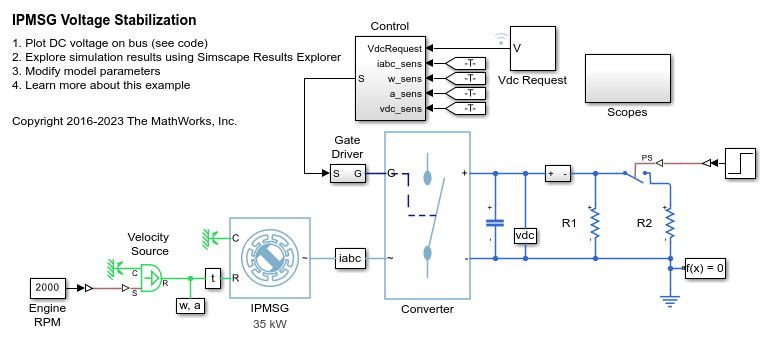PWM Generator (Three-phase, Two-level)
3상 2레벨 펄스 폭 변조 파형 생성
라이브러리:
Simscape /
Electrical /
Control /
Pulse Width Modulation
설명
PWM Generator (Three-phase, Two-level) 블록은 3상 2레벨 전력 컨버터의 전환 동작을 제어합니다. 이 블록은 다음 작업을 수행합니다.
다음과 같은 블록 입력을 기준으로 온게이팅 시간과 오프게이팅 시간을 계산합니다.
세 개의 정현파 기준 전압(1상당 하나)
DC 링크 전압
게이팅 시간을 사용하여 6개의 스위치 제어 펄스를 생성합니다.
게이팅 시간을 사용하여 변조 파형을 생성합니다.
연속 PWM 및 불연속 PWM
블록은 연속 펄스 폭 변조(PWM)와 이산 펄스 폭 변조(PWM) 모두에 대한 모드를 제공합니다. 다음 그림은 연속 정현파 PWM(SPWM) 파형과 연속 공간 벡터 변조(SVM) 파형 간의 일반적인 차이점을 보여줍니다.

불연속 PWM(DPWM)의 경우 블록은 기본 주기마다 변조파를 총 120도 구간에 걸쳐 양의 DC 레일 또는 음의 DC 레일에 클램핑합니다. 클램핑 구간에서는 변조가 중단됩니다.
30도 DPWM을 가진 파형은 기본 주기당 4개의 30도 구간을 갖습니다.

60도 DPWM에 대해 양의 30도 위상 변위 또는 음의 30도 위상 변위를 선택하면 클램핑 구간에 영향을 미칩니다.

다음 그림은 120도 DPWM에 대한 양의 DC 클램핑과 음의 DC 클램핑의 파형을 보여줍니다.

샘플링 모드
이 블록을 사용하면 변조파에 대해 자연 샘플링, 대칭 샘플링 또는 비대칭 샘플링을 선택할 수 있습니다.
PWM Generator (Three-phase, Two-level) 블록은 반송파 기반 PWM을 수행하지 않습니다. 대신에 이 블록은 입력 신호를 사용하여 게이팅 시간을 계산한 다음, 해당 게이팅 시간을 사용하여 스위치 제어 펄스와 출력할 변조 파형을 모두 생성합니다.
한편, 반송파 기반 PWM은 선택한 샘플링 모드가 이 블록이 생성하는 펄스의 스위치온 동작 및 스위치오프 동작과 어떻게 관련되는지 보여주는 데 유용합니다. 2레벨 반송파 기반 PWM 방법을 사용하는 생성기는 다음을 수행합니다.
기준파를 샘플링합니다.
샘플을 삼각 반송파와 비교합니다.
샘플이 반송파 신호보다 높은 경우에는 스위치온 펄스를 생성하고 샘플이 반송파보다 낮은 경우에는 스위치오프 펄스를 생성합니다.
스위치온 펄스 동작과 스위치오프 펄스 동작을 결정하기 위해 2레벨 반송파 기반 PWM 생성기는 다음 방법을 사용하여 삼각파를 샘플링합니다.
자연 — 샘플링 및 비교가 변조파와 반송파의 교점에서 발생합니다.

비대칭 — 샘플링이 반송파의 상부 경계와 하부 경계에서 발생합니다. 비교는 샘플링을 한 이후에 교점에서 발생합니다.

대칭 — 샘플링이 반송파의 상부 경계에서만 발생합니다. 비교는 샘플링을 한 이후에 교점에서 발생합니다.

과변조
전력 컨버터가 주어진 전압을 출력할 수 있는지를 측정하는 변조 인덱스는 다음과 같이 정의됩니다.
여기서 각각은 다음과 같습니다.
m은 변조 인덱스입니다.
Vm은 변조파의 피크 값입니다.
Vc는 삼각 반송파의 피크 값입니다.

3상 SPWM의 경우는 다음과 같습니다.
여기서 각각은 다음과 같습니다.
Vpeak는 상-중성점 전압의 기본 성분의 피크 값입니다.
vdc는 DC 링크 전압입니다.
3상 공간 벡터 PWM(SVM) 및 DPWM의 경우는 다음과 같습니다.
일반적인 정상 상태 동작의 경우 0 <m ≤ 1입니다. 부하 증가와 같은 과도로 인해 Vm의 진폭이 Vc의 진폭을 초과하는 경우 과변조(m > 1)가 발생합니다.

과변조가 발생하면 전력 컨버터의 출력 전압은 양의 DC 레일 또는 음의 DC 레일에 클램핑됩니다.
3상 2레벨 PWM 생성기 예제에서, Two-Level Controller 서브시스템은 400V DC 링크 입력과 0.8의 변조 인덱스 m을 포함하고 있습니다. SPWM의 경우 최대 입력 전압은 400V/2, 즉 200V입니다. 과변조를 보여주기 위해 시뮬레이션 시작 시점에 과도가 추가됩니다. 이 과도는 기준 전압의 진폭이 DC 링크 전압 진폭의 1/2을 초과하도록 만듭니다. 과변조를 강조하기 위해, 스코프는 6개의 출력 펄스 중 하나에 대한 시뮬레이션 결과와 기준 전압, 변조 파형, 출력 전압의 a상에 대한 시뮬레이션 결과만 포함하고 있습니다.

0.03~0.09초에서 변조 인덱스는 1보다 큽니다. 과변조 시 다음이 수행됩니다.
펄스는 켜진 상태 또는 꺼진 상태를 유지합니다.
출력 전압 Vao는 양의 DC 레일 또는 음의 DC 레일에 클램핑됩니다.
예제
포트
입력
출력
파라미터
참고 문헌
[1] Chung, D. W., J. S. Kim, and S. K. Sul. “Unified Voltage Modulation Technique for Real Time Three-Phase Power Conversion.” IEEE Transactions on Industry Applications, Vol. 34, No. 2, 1998, pp. 374–380.
[2] Hava, A. M., R. J. Kerkman, and T. A. Lipo. “Simple Analytical and Graphical Methods for Carrier-Based PWM-VSI Drives.” IEEE Transactions on Power Electronics, Vol. 14, No. 1, 1999, pp. 49–61.
확장 기능
버전 내역
R2016b에 개발됨

















